





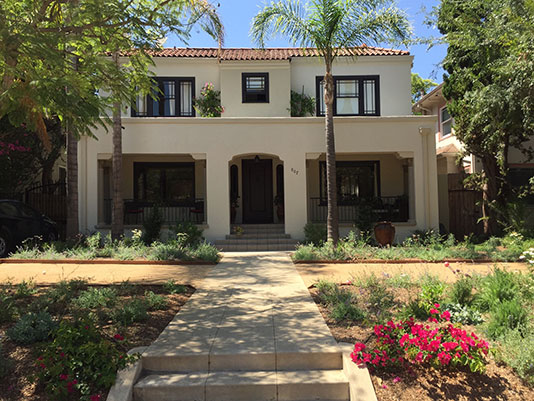
One month after planting, the garden/bocce court is abuzz with pollinators.
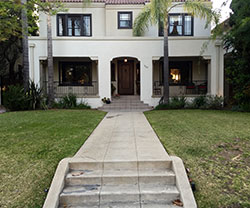
Before: The lawn was looking pretty beat up because of reduced water rations.
By Julie Grist
WE’VE always loved our front yard: two patches of green lawn embracing a front walkway, shaded by a purple flowering jacaranda tree. We sit out on the sunny front porch on weekend mornings watching neighbors walk their dogs. Every fall we pop poles into umbrella stands on the front walk and roll out the badminton net, drawing the family out to play a stirring game of birdies on rackets, which usually lures a few neighbors to join the fun.
But that green grass no longer looks so enticing now that we’re in our fourth year of drought in southern California. Los Angeles has instituted some strict guidelines on reducing water use. A city ordinance passed in June 2015 year put Los Angeles in phase two of water restrictions allowing only 8 minutes of sprinkler use three times a week, no washing of cars or sidewalks, and the ability to report others’ water leaks to the water department, which can slap a fine on residents and businesses who don’t repair leaks.
“Drought shaming” is the new norm, with residents able to anonymously report water wasters and leaking sprinklers on a government website. Water is not served at restaurants unless one specifically requests it, and the Save the Drop campaign has even reached toddlers, who know not to run the tap while brushing their teeth.
So what to do about our front lawn, slowly turning from green to brown before our eyes? We live in an old neighborhood in the central part of Los Angeles, aptly named Hancock Park for its expanse of large green lawns that roll out like a park, beautifully framing the 1920s architecture of homes in this historic district. The City of LA began to offer turf removal rebates, offering $2 to $4 cash per square foot of lawn removed, to be replanted with drought-tolerant landscaping. Many Angelenos quickly started ripping out their lawns. Some planted cactus and spread gravel, others looked to the Mediterranean palette of plants.
My own family debated. We wanted to do our part, but knew we’d miss using the front yard as our badminton “play” ground. I knew I wanted to plant native California flora that could serve as habitat and food for the birds, bees and butterflies, but also knew that most native plants wouldn’t survive the trampling of badminton. Then we realized we could have it all: We’d build a bocce court surrounded by native, pollinator-friendly plants.
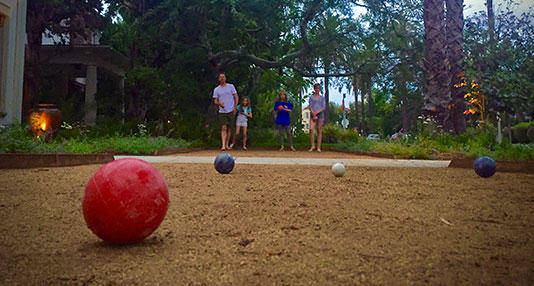
The flowers attract pollinators; the bocce court attracts neighbors.
The turf removal rebate guidelines allow for a portion of the surface to be “hardscaped” with a permeable surface, so our planned 12 x 45 foot bocce ball court could be framed in timber and rolled with decomposed granite. Spanning the six-foot concrete walkway makes for more interesting — but not impossible — play.
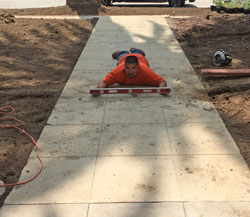
Checking the grade for the intersection of the bocce court and the front walk.
Working with a landscape designer who knows her natives, (Sloan Foxe Ashley of Wormwood Designs) we drew up a plant list and sketched out the design. Our aim was to attract birds, bees and butterflies, with a special focus on providing the habitat and food for butterflies, especially the monarch. Because milkweed is the sole food source for the caterpillars that become monarch butterflies, we had to include narrow-leaf milkweed (Asclepias fascicularis), which is indigenous to California. We filled out the rest of the garden with colorful "summer dry" plantings, many of them California natives: ceanothus (wild lilac), echinacea (coneflower), a variety of salvias and penstemons, buckwheats, native pelargonium (geranium), catmint, rock purslane and coyote mint.
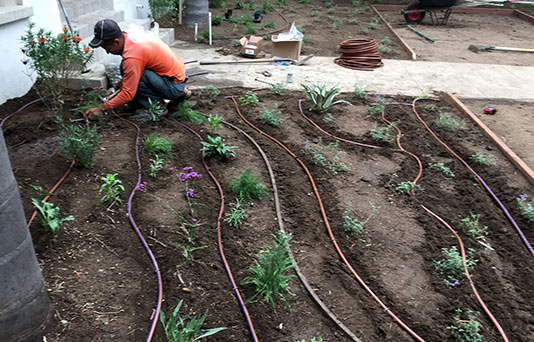
Drip irrigation waters with little waste. Once plants are established, watering can be reduced even further.
A drip-irrigation system that lies below the mulch and above the soil now waters the garden. Once the plants are established, water use will be minimal. The plants are thriving in the hot, sunny, eastern exposure and many neighbors have reported seeing more butterflies in their gardens. The catmint is abuzz with bees, the birds drink and bathe in the small fountain nearby, and my dog even chomps on the echinacea when his stomach doesn’t feel quite right.
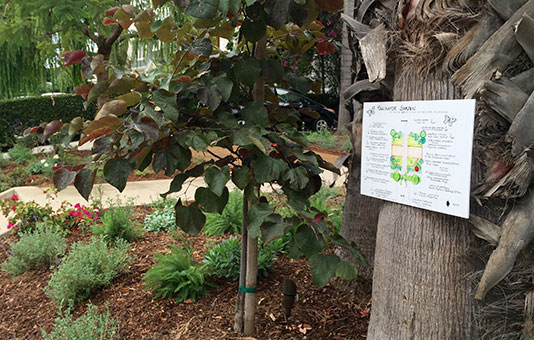
A sign explains the garden to curious passersby.
We can’t help but feel we’re going in the right direction: reducing water use and providing habitat for some of the winged species who fly through this vast urban city, and alight happily on our small swath of wildflowers. It also draws our children and neighbors out front to a game of bocce ball in the evening and a chance to commune. Best of all — I’m perfecting my bocce game and currently hold the record number of wins on the block, even though I’m often distracted by the fluttering of wings on the sidelines.

Julie Grist is a writer, publisher and photographer who lives in the heart of Los Angeles with her husband and three children. She loves to weed her front garden, talking with neighbors and passersby about plants, historic preservation and pollinators.
Copyright © www.100flowers.win Botanic Garden All Rights Reserved